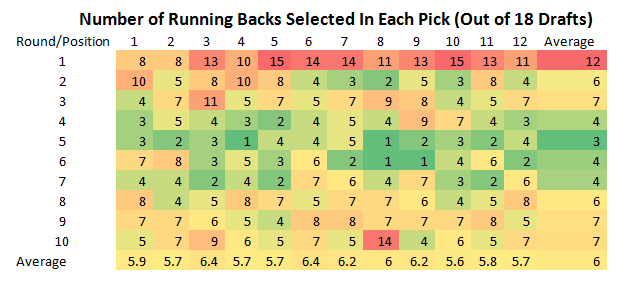Advanced Draft Preparation: An In-Depth Study on Running Back Drafting
“Whoever is first in the field and awaits the coming of the enemy, will be fresh for the fight; whoever is second in the field and has to hasten to battle will arrive exhausted. ”
– Sun Tzu(The Art of War)
 As part of our on-going series about advanced draft preparation, we will delve deeper into the drafting habits observed in Dynasty League Football’s mock draft series hosted by DLF’s own, Ryan McDowell’s (@RyanMC23). This article will focus solely on the running back position and what trends or behaviors a start-up draft owner may be able to exploit. For background on the methodology and research conducted to obtain these results please check the first article in this search entitled “Advanced Draft Preparation – Annihilating Herd Mentality”.
As part of our on-going series about advanced draft preparation, we will delve deeper into the drafting habits observed in Dynasty League Football’s mock draft series hosted by DLF’s own, Ryan McDowell’s (@RyanMC23). This article will focus solely on the running back position and what trends or behaviors a start-up draft owner may be able to exploit. For background on the methodology and research conducted to obtain these results please check the first article in this search entitled “Advanced Draft Preparation – Annihilating Herd Mentality”.
Please note that each positional article should be viewed as a self-contained work that relates only to the original piece. Each positional piece should not be viewed as being compatible with other positional pieces. The strategies laid out in each positional piece are specific only to the position being examined and a strategy in one positional piece may run counter to a separate strategy in a different position piece. Each positional piece will seek only to maximize the value of the subject position.
In the previous article of this series we examined quarterbacks and how you may be able to wait on a quarterback for a few rounds before making a selection. The same is not true for running backs, as many of you know. Running backs have always been the focal point of fantasy teams since the invention of fantasy football and the dynasty format is no different.
On average, in the leagues examined in this series, 12 running backs were selected with each pick of the first round out of 18 possible picks. That means that two out of every three picks in the first round were likely to be a running back. Clearly running back is not a position you want to miss out on.
The next question may sound funny to many but, why? Why do running backs come off the board so quick and so regularly while other positions see a much more even distribution? The answer is very complicated but is something that fantasy football players, especially those in dynasty leagues need to completely and fully understand.
First, the history of fantasy football has always favored the running back position. In the early days of the game it was hard to find even eight guys who liked football, were adventurous enough to try a new game, had enough money to join a league, were smart enough to understand the connection between fantasy football and real football, were patient enough to play through a whole season and who straddled that fine nerd/jock line. Oh, by the way, it would help if you actually liked everyone you were playing against. Did I mention this was before the internet too? As you can see the 12-team league we are generally familiar with was yet to be even a twinkle in the internet’s eye in these prehistoric days. Why the history lesson? Simple, the more things change, the more things stay the same.
In those early days of fantasy football everyone had a stacked lineup from top to bottom. What decided games between teams wasn’t the deep sleeper you drafted in the 10th round, no it was whose team was more stacked. During these early days even the NFL, just like the fantasy game, was not the same NFL we have today. No matter when you mark the genesis of fantasy football, one thing is certain, it was firmly establishing its roots by the mid-1980’s. At this time the running game was king. The passing game we see today was absolutely unfathomable by players of that era. For instance, in 1985 Dan Marino was the NFL passing yards leader throwing for 4,137 yards. In 2012, eight different quarterbacks threw for more than that amount! Here is another interesting statistics to help set the stage for our little jaunt down memory lane; only one entry in the top 10 passing yards per season record book still exists prior to the year 2000. Meanwhile only three running backs since 2000 have cracked the top 10 rushing yards per season record book. Suffice to say, the game has changed radically since fantasy football was first created. In the early days running backs scored your fantasy team the most points, period.
So with the transition from a rush heavy league to a pass heavy league why do we not see quarterbacks flying off the board in the first round? Why do we still see a running back saturated round one, and even round two?
Well, here’s where things get complicated. First, in the early days running backs were plentiful, every team had their running back that they leaned on heavily. This running back was “the man” and for the most part there was one on every team in the NFL. You drafted running backs early because you wanted the best of the best and that’s where your points were going to come from. Nowadays fantasy players are forced to draft running backs due to the scarcity of the position. It is not uncommon in the modern game to see teams that employ a running back by committee (RBBC) approach or even largely ignore the running game in favor of a pass heavy attack. This scarcity creates demand, and like anything in demand from a new device to a “gotta have it” Christmas toy, this demand creates runs. People don’t want to be the odd man out without said item so they’ll stand in long lines in real life or fantasy football they’ll wait their turn in the draft order to get their running back in the early round rush.
The thought-process behind this phenomenon seems so “lemming-esque” but it is rooted in firm reasoning when we look at the numbers. In the 18 drafts examined, the average point total for those running backs selected in the first round was 280.27, the average point total for those running backs selected in the second round was 225.23. The drop between round one and round two in terms of production is substantial with a 55.04 point drop, or roughly a 20% drop round over round. However, by the time round three rolls around the change is staggering. The average point total for a running back selected in round three was 154.08! That is a 71.15 point drop from round two to round three and a 126.19 point drop from round one to round three, drops of 32% and 45% respectively. Essentially your average running back taken in round three is almost half as valuable as a running back taken in round one!
Everyone knows about the two running back strategy, it is employed by a massive amount of fantasy football players. Essentially it promotes the taking of two running backs in with your first two draft picks. This strategy is about as standard fare as it gets in fantasy football. So what can a dynasty player do to get a solid edge on his or her competition? Simple, if selecting two running backs early is good, selecting three must be even better!
Am I seriously proposing taking running backs with your first three picks? Yes, I absolutely am. The reasoning behind this is that bell cow running backs are so hard to come by in this game that they are worth their weight in gold. Doing so also makes it nearly impossible for the position to be a liability for the owner performing this strategy.
As a test of this strategy I decided to roll it out in a new dynasty league I started up this offseason. I drafted from the 1.09 position and came away with LeSean McCoy, Alfred Morris and Lamar Miller in three straight picks. In this league you can start as many as five running backs for the strategy was a smashing success. I now absolutely control the running back market as I went on to stock up even further with the addition of Frank Gore in the sixth round and Daryl Richardson in the 14th round. Just to further drive the point home and really shore up my picks I even grabbed some of their back-ups in later rounds with Kendall Hunter in the 19th, Mike Gillislee in the 20th and possible back-up Chris Thompson in the 44th round. The addition of each back-up made the original selection that much more valuable because I can now provide a running back and insurance on that running back in trade offers, making the offer much more attractive to a potential trade partner. If I don’t wish to trade I can also feel extremely secure in my running back situations and shouldn’t have too many cares for years to come.
The downside to this strategy is of course the fact that you must ignore other positions to pull this off. That is a legitimate concern but in actuality this strategy can free you up to be much more adventurous with your later picks. If employed with the quarterback strategy mentioned in the article entitled “Advanced Draft Preparation – An In-Depth Study on Quarterback Drafting”, an owner can focus solely on wide receivers and tight ends from the sixth round on. Conversely, if only two running backs were selected by a team at the top of the draft they must now draft running backs later as well as possible insurance or for fliers.
“That’s way too late to start hitting wide receivers,” I can hear some of you screaming. Actually, it’s not at all. Looking at MyFantasyLeague.com’s Average Draft Position (ADP) listing we can see wide receivers such as Danny Amendola, Antonio Brown, Michael Crabtree, Stevie Johnson, Josh Gordon, TY Hilton and Jeremy Maclin can all be had in or after the sixth round. Sure, none of them are Calvin Johnson or AJ Green but they will put up more than sufficient numbers for any owner on their team. Meanwhile, you would now have a team composed of the three running backs I listed and two top six quarterbacks. Such a team would easily make the playoffs in any league and would more than likely be in contention for the championship for the foreseeable future. Meanwhile you would absolutely drain the talent pool at two of the most significant positions in the game.
Such a strategy is obviously going to be controversial, especially when an owner employs it in conjunction with the quarterback strategy as discussed earlier in this article. However, the proof is in the pudding, try it out in a mock draft or two and see what you think. If you’re especially brave try it out in your new start-up and see how it plays out, I did! Worst case you have a lot of trading options at your disposal or you can focus on wide receivers in upcoming drafts. Either way, an owner that pursues this strategy, or combination of strategies, will have a lot more latitude to shape their team then the average dynasty owner ever dreamed of.




































































